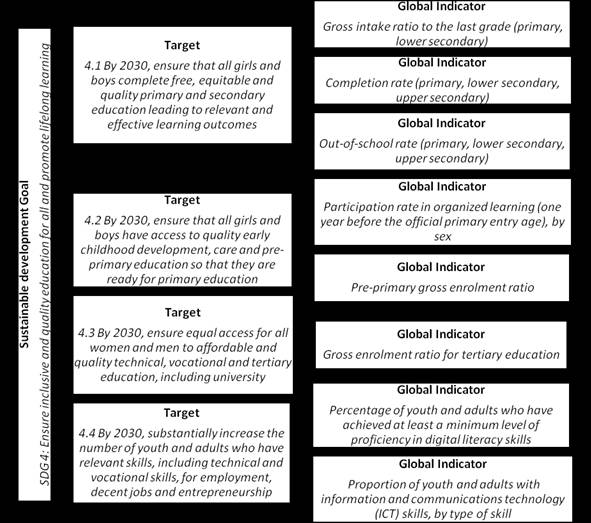如何判断企业为SDGs落地做出了贡献?
2017-02-28金蜜蜂胡文娟(编译)

SDGs正式实施一年以来,虽然我们已经清楚认识到了工商业界在落实SDGs中的责任和机遇,企业也积极地期盼着为促进目标实现开展各类活动。但在具体执行过程中,企业依然面临着各种挑战,而如何监控、测量、评估企业SDGs相关活动的成果就是面临较大困难的环节之一。
曾有人说,无法度量就无法管理。就SDGs 17个目标执行情况的测量以及与之相匹配的企业活动成果的评估,包括如何定量或定性判断企业为SDGs落地做出了贡献正是本文想要传递和表达的。
作者Zheng Ying Chong以如何测量SDG 4执行情况的官方数据和企业惯用数据/信息为例,展示了企业将活动结果的测量指标量化并同联合国教科文组织数据研究院的官方数据相匹配的困难程度和复杂程度,同时也提醒广大企业在将活动对准目标的同时,一定要考虑如何测量结果并想办法将其同官方数据相匹配。
以下为原文
就如何促进联合国可持续发展目标(SDGs)的实现,工商业界已喋喋不休地展开了大量讨论,许多企业如喜力、联合利华等也都非常努力地比照SDGs筹划了各种活动(无论是核心业务、慈善活动还是社区投资)。
这都反映出了企业的清晰意图,即期待为SDGs进展付出贡献。
虽然这些企业活动可能为促进17个目标中的1个或多个目标的实现做出了贡献,但在用于追踪SDGs进展的官方指数和企业为证明自己促进SDGs实现所追踪的数据\信息之间,似乎存在着一些差距。
SDGs进展是一个数据驱动的过程
虽然从本质上讲SDGs是雄心勃勃的,但它们也有一个已经建立好的指数框架和统计数据库,用来监控目标进展、为政策规划提供信息、明确所有利益相关方的责任。每一个目标与其子目标连接,每一个子目标又都有全球指数(Global Indicators)来测量其进展。这些全球指数又进一步被分解为主题指数(Thematic Indicators)。
17个SDGs共有169个子目标,而这些子目标的进展则可以通过230个独特的全球指数来衡量、追踪。
下表展示了可持续发展目标背后所设置的框架概述。本文将SDG 4作为一个例证。请注意SDG 4共有10个子目标,11个全球指数和43个主题指数,图表中并未列出所有指数。

(可持续发展目标背后框架的图示法。此表以SDG4 所涉及的教育目标为例。请注意,SDG4共有10个子目标,11个全球指数和43个主题指数,所有指数并未尽列于此。上图表仅做例证。)
为了掌握目标SDG 4在教育方面的进展,联合国教科文组织统计研究所(简称UIS)通过从成员国和其它被认可的国际组织(如世界银行,IMF等)收集统计数据并通过验证和标准化过程,制作了一套具有可比性的国际间官方统计数据。
作为联合国统计体系的一部分,UIS同一些依据广泛数据源编制和报告官方统计数据的政府组织展开协作。这些数据源通常包括从独立评估中心、研究人员及其它组织或人员处收集到的数据,但是国有管理的或受管制的教育机构或院校更容易获取这些数据。
假定在SDGS进展测量中,与其相符合活动的贡献可以被捕捉
大多数期待为落实SDGs做出贡献的公司,已经开始依据各个目标来筹划和开展企业活动。然而,这同将这些活动成果同全球指数——决定通向目标进展的数据点集,相匹配是完全不同的。
将SDG4作为一个参考点,例如一个公司列出了一系列诸如支持、促进边缘儿童享有初等教育的项目活动,但公司并未列出这些活动的结果或输出是如何促成或影响了被追踪的全球指数数据点集(例如,在这种情况下,相关的数据点可能是活动如何影响了目标4.1之下的小学失学率)。
尽管很明显,这些活动的目的与SDG 4相一致,人们也可以很安全地假定企业的努力有助于从整体上降低国家层面的小学失学率,但还是缺乏相关的报告来解释这些项目的结果是如何在被测量的更大的国家背景下(或国家层面的数据上)进展的。
在一些情况下,也不清楚诸如SDG指南(SDG compass)等工具(一本指导企业如何测量、管理其为SDG指标落实所做贡献的工具书)是如何同全球指数相对应的。SDG指南将SDG目标与GRI、联合国全球契约-乐施会贫困足迹(Oxfam Poverty Footprint)等常用的业务框架相对应。
这些框架中的指数可以作为指标使用,用来证明企业为SDG实现做出了贡献。
尽管这些被确认的业务指标与其对应的联合国可持续发展目标之间有清晰的联系,但是现在还不清楚全球指数是否能够很好地捕捉这些企业活动的成果。这也许并不是指所有业务指标,但是对一些已经确认的业务指标来讲,似乎很难发现其与官方追踪的全球指数之间的显性联接。
以SDG4为例,子目标4.3的成功即“到2030年,确保所有男女平等获得负担得起的优质技术、职业和高等教育,包括大学教育”,是通过统计青年和成年人在之前12个月参与正式和非正式教育、培训的比例(按性别分类)来官方测量该目标进展情况的。
而与其相对应的,被建议使用的业务指标则来自于GRI G4可持续发展报告指南,即通过计算每年每名员工接受培训的平均小时数(按性别、员工类别分类)来测量企业活动成果。
可以推测,定期接受培训的员工都是公民,因此这些公民所接受的培训也应该被围绕正式和非正式教育培训参与率的国家数据所收纳。但不管怎样,这还只是一个假设,同时这也提出了问题,即官方数据在追踪什么,没追踪什么。
越过这一问题即企业的努力能否被官方SDG指数捕捉,几乎不可能定性成绩或正确判定实际上商业为SDG的落实做出了多少贡献。
虽然如此,企业也不应该由于对照SDG报告活动成果困难而感到气馁,因为这些可持续发展目标从本质上讲就很复杂,且它们也确实拥有除了全球指数以外的其它更好地来帮助我们测量进展的指标。
例如,SDG不仅关注早期教育,同时还聚焦终身教育,这就涉及到儿童早期教育,青年和成年学习等。这些目标的进展测量起来都很富有挑战性,很多时候在如何定义影响和测量成果上也很难达成一致意见。但是SDGs的确给予人类更强大的动力来寻找解决方案,学习他人并在国家和地区层面上建立起更加全面的信息系统。
目前,SDG 4的教育目标涉及很大范围,包括从早期儿童教育到成年教育。一个能帮企业更好确保活动成果与SDGs进展相匹配的方法就是,将国家议程/优先领域(和/或其它合作伙伴,诸如民间社团组织等)当做信号。在亚洲,联合国教科文组织表示将会重点关注青年技能和全球公民意识和可持续发展教育,国家将带头制定框架和发展措施来更好地记录这些领域。
现实情况是基于个体组织的报告,一些商业数据很难在全球层面上完成汇编(通常是通过企业调查或劳动力调查收集数据以及基于企业或个体样本来评估国家进展),同时人们也不应该低估定性指标所呈现的价值。
因为服务目标、对话群体不同,所以测量指数也会不同,企业可以对照可持续发展目标及子目标的具体愿望,提供能够更好呈现其具体贡献的指数。
随着企业持续开展活动贡献SDGs落地,他们应该意识到通过官方全球指数在全球层面展现自己努力可能并不是直接包括企业的报告数据。为了进一步表明企业在毫无疑问地为SDGs进展带来积极影响,企业就不应该只考虑目标本身,而是要同时关注全球指数并依据相关国家平均水平来报告活动成果和输出,或者通过某一种方法来展示活动与国家优先领域的一致性。
(本文编译自CSR ASIA网站2017年1月18日文章:《How do we know businesses are contributing to theSustainable Development Goals?》,作者为Zheng Ying Chong)
以下为英文原文
How do we know businesses are contributing to the Sustainable Development Goals?
There has been a lot of chatter amongst the business community about contributing to the Sustainable Development Goals (SDGs), with numerous businesses, such as Heineken and Unilever diligently mapping activities (whether core business, philanthropic or community investment) against the SDGs. This reflects clear intent to contribute to the progress of the SDGs.
While such activities have likely contributed to one or more of the 17 Goals, there appears to be a gap between the official indicators used to track progress against the SDGs and the data/information businesses are tracking to evidence their contributions to progress.
Progress on the SDGs is a data driven process
While the SDGs are aspirational in nature, they have a framework of indicators and statistical data set up to monitor progress, inform policy and ensure accountability of all stakeholders. Each Goal is linked to Targets, the progress of which are measured by Global Indicators. These Global Indicators are further broken down into Thematic Indicators. The 17 SDGs have a total of 169 accompanying Targets, progress of which are tracked through 230 unique Global Indicators.
Figure one provides an overview of the framework set behind each SDG. SDG 4 is used as an illustrative example. Please note SDG 4 has a total of 10 Targets, 11 Global Indicators and 43 Thematic Indicators, not all of which are listed here.
1 Diagrammatic representation of the framework behind a Sustainable Development Goal. Figure provides an example using SDG 4 on Education. Please note, SDG 4 has a total of 10 Targets, 11 Global Indicators and 43 Thematic Indicators, not all of which are listed. The above diagram is for illustrative purposes only.
To understand progress against SDG 4 on Education, the UNESCO Institute for Statistics (UIS) works to produce internationally comparable official statistics by gathering statistics from Member States and other recognised sources of information (e.g. World Bank, IMF) and putting it through a process of validation and standardisation. The UIS, as part of the UN statistical system, works with governments that compile and report official statistics often based on a wide range of data sources. These often include data collected by independent assessment centres, researchers and others, but data are more readily available for state-administered or regulated education providers.
Assumptions that the contribution of aligned activities are captured in the measurement of SDG progress
Most companies looking to contribute to the SDGs have mapped activities they are undertaking against the various Goals. This, however, is quite different from matching outcomes from these activities against the Global Indicators – the data points that determine progression towards Targets.
Using SDG 4 as a reference point, a company would, for example, list activities such as support for programmes boosting access to primary education for marginalised children, but not how the outcomes or outputs of these activities have contributed to or impacted the Global Indicator datapoints being tracked (e.g. in this case, a relevant data point could be how the activity has impacted Out of school primary rates under Target 4.1). While these activities are clearly aligned and one could safely assume their efforts would contribute to the overall lowering of out of school primary rates at a national level, there is little reporting around how the results of these programmes fare in the larger national context which is being measured.
In some cases, it is also unclear how tools such as the SDG Compass, which provides guidance for how companies can measure and manage their contribution to the realisation of the SDGs indicators, align with the Global Indicators. The SDG Compass maps SDG Targets against commonly used business frameworks such as the Global Reporting Initiative (GRI) and the UN Global Compact-Oxfam Poverty Footprint. Indicators from these frameworks act as indicators companies could use to evidence their contribution toward the SDGs. While these identified business indicators have clear links to the Targets they are mapped against, it remains unclear if the Global Indicators capture the results of these activities. This might not be the case for all business indicators, but the explicit link between the Global Indicators that are being officially tracked seems to be difficult to ascertain for some identified business indicators.
Taking one of the Targets for SDG 4 as an example, the success of Target 4.3, to ensure equal access for all women and men to affordable and quality technical, vocational and tertiary education, including university by 2030, is officially measured by the participation rate of youth and adults in formal and non-formal education and training in the previous 12 months, by sex. The suggested business indicator comes from GRI G4 Sustainability Reporting Guidelines, looking at the average hours of training per year per employee by gender, and by employee category. One can presume that regularly trained employees would be citizens and therefore the training those citizens received would have been captured in national data around formal and non-formal education and training participation rates. This however remains an assumption and raises questions over what official data is tracking and what it’s not.
Beyond the question of whether or not business efforts are captured in official SDG indicators, it is virtually impossible to attribute progress and determine just how much businesses are actually contributing to the SDGs.
However, businesses should not be discouraged from reporting alignment to the SDGs, as these Goals are complex in nature and have other indicators besides the Global Indicators which can help to tell the story as well. For example, the SDGs put the focus on life-long learning not only in initial education, but in relation to early childhood development, youth and adult learning. These can be challenging areas for measurement, where there is not always consensus on how to define and measure, but the SDGs give greater impetus to finding solutions, learning from others and building up more comprehensive information systems at the national and regional levels. SDG 4’s education targets currently cover a large spectrum, from early childhood education to adult education. A good way for businesses to better ensure alignment would be to take national agendas/priorities (and/or other partners such as civil society organisations) as signals. In Asia, UNESCO shares that there is a strong focus on youth skills and global citizenship and education for sustainable development and countries are taking the lead in framing and developing measures to better capture these areas.
The reality is that some of these business data would be difficult to compile at a global level based on reporting from individual organisations (and are typically collected through enterprise surveys or Labour Force Surveys and estimates for the country based on a sample of enterprises or individuals) and one should not discount data presented in a more qualitative way. Indicators differ as they serve different purposes and speak to different audiences, a business can align to the specific aspirations of the Goals and Targets, and present indicators which best capture their specific contribution.
As business continues to support the SDGs, they should be aware that efforts being captured at the global level through the official Global Indicators may not directly include business reported data. To further show that one’s business has undoubtedly had a positive impact on the progress of SDGs, businesses should consider looking not just at the Targets but also at the Global Indicators and report outcomes and outputs of their programmes against related national averages or in a way that shows clear alignment with national priorities.
(责任编辑:小黑)












